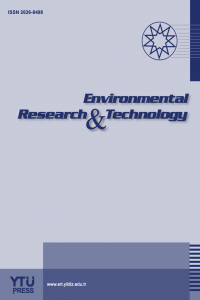The evaluation of factors in utilizing the potential of solar energy: the case of Turkey
Energy use Semi-structured interview, Solar energy, Turkey,
___
- [1]. A. Gürses, “Türkiye’de İnovatif Bir Çatı Kaplama Malzemesi Geliştirilmesi Süreci Önerisi,” Beykent Üniversitesi Fen ve Mühendislik Bilimleri Dergisi, Vol. 11 (2), pp. 2-18, 2018.
- [2]. K.B. Varınca and M.T. Gönüllü, “Türkiye’de güneş enerjisi potansiyeli ve bu potansiyelin kullanım derecesi, yöntemi ve yaygınlığı üzerine bir araştırma,” in Proc. UGHEK’06, pp. 270-275, 2006.
- [3]. BP, “BP Statistical Review of World Energy 2019,” BP, London, UK. 2019
- [4]. M. Karacaer Ulusoy, “Rakamlarla Türkiye’nin Enerji Görünümü,” Available: https://www.sde.org.tr/merve-karacaer-ulusoy/genel/rakamlarla-turkiyenin-enerji-gorunumu-kose-yazisi-7155, (accessed 18 February 2019)
- [5]. TCMB, “Elektronik Veri Dağıtım Sistemi,” Available: https://evds2.tcmb.gov.tr/index.php?/evds/serieMarket/collapse_18/5973/DataGroup/turkish/bie_odayr6/, (accessed 19 April 2019)
- [6]. D. Uysal, K. Yılmaz, and T. Taş, “Enerji ithalatı ve Cari açık ilişkisi: Türkiye Örneği,” Anemon Muş Alparslan Üniversitesi Sosyal Bilimler Dergisi, Vol. 3 (1), pp. 63-78, 2015.
- [7]. M. Narin and Y. Gholizadeh, “Avrupa Birliği ve Türkiye’nin Yenilenebilir Enerji Politikalarının Karşılaştırılması,” in Proc. International Conference on Eurasian Economies 2018, pp. 277-285, 2018.
- [8]. IEA, “Key world energy statistics,” Available: https://www.iea.org/publications/freepublications/publication/KeyWorld2017.pdf, (accessed 17 April 2019)
- [9]. O. Yılmaz, “Yenilenebilir Enerjiye Yönelik Teşvikler ve Türkiye,” Adnan Menderes Üniversitesi Sosyal Bilimler Enstitüsü Dergisi, Vol. 2 (2), pp. 74-97, 2015.
- [10]. R. İraz, A. İsa, and H.S. Peker, “Güneş Enerjisi Yatırımlarına Yönelik Teşvikler ve Türkiye’deki Durum,” Selçuk Üniversitesi Sosyal Bilimler Meslek Yüksek Okulu Dergisi, Vol. 13 (1-2), pp. 69-78, 2010.
- [11]. F. Dinçer, “Türkiye’de Güneş Enerjisinden Elektrik Üretimi Potansiyeli-Ekonomik Analizi ve AB Ülkeleri ile Karşılaştırmalı Değerlendirme,” Kahramanmaraş Sütçü İmam Üniversitesi Mühendislik Dergisi, Vol. 14 (1), pp. 8-17, 2011.
- [12]. J.J. Santos, J.C. Palacio, A.M. Reyes, M. Carvalho, A.J. Freire, and M.A. Barone, “Concentrating solar power,” In Advances in Renewable Energies and Power Technologies (pp. 373-402), Elsevier. 2018
- [13]. Y.L. He, Y. Qiu, K. Wang, F. Yuan, W.Q. Wang, M.J. Li, and J.Q. Guo, “Perspective of concentrating solar power,” Energy, Vol. 198, 117373, 2020.
- [14]. F.Z. Zerhouni, M.H. Zerhouni, M. Zegrar, M.T. Benmessaoud, A.B. Stambouli, and A. Midoun, “Proposed methods to increase the output efficiency of a photovoltaic (PV) system,” Acta Polytechnica Hungarica, Vol. 7 (2), pp. 55-70, 2010.
- [15]. V.V. Tyagi, N.A. Rahim, and J.A.L. Selvaraj, “Progress in solar PV technology: Research and achievement,” Renewable and Sustainable Energy Reviews, Vol. 20, pp. 443-461, 2013.
- [16]. A. Zahedi, “Solar photovoltaic (PV) energy; latest developments in the building integrated and hybrid PV systems,” Renewable energy, Vol. 31 (5), pp. 711-718, 2006.
- [17]. Solar Cell Central (2019). World Wide PV Solar Growth. Available: http://solarcellcentral.com/markets_page.html, (accessed 17 June 2020)
- [18]. https://www.statista.com/, The Statista website. [Online]. Available: (2020)
- [19]. https://www.dunyaenerji.org.tr/turkiye-enerji-denge-tablolari/, The World Energy Congress website. [Online]. Available: (2021)
- [20]. https://enerji.gov.tr/gunes, Republic of Turkey Ministry of Energy and Natural Resources website. [Online]. Available: (2019)
- [21]. Ilbank, “Güneş Enerjisi,” https://www.ilbank.gov.tr/sayfa/gunes-enerjisi, (accessed 17 June 2020)
- [22]. M.B. Miles and A.M. Huberman, Qualitative data analysis: An expanded sourcebook.2nd Edition. USA: Sage, US. 1994.
- Yayın Aralığı: Yılda 4 Sayı
- Başlangıç: 2018
- Yayıncı: Yıldız Teknik Üniversitesi
Adebola DARAMOLA, Ese EBHUOMA, Victoria AKINYEMI
Erdem GÖRGÜN, Kardelen ADSAL, Aybike MISIR, Eyüp AYDİN, Çağdaş ERGÜN, Nihan KESKİN, Aynur ACAR, Şeyla ERGENEKON
Abdelaziz Y. MOHAMED, Orhan CANPOLAT, Mukhallad Mohammed Mawlood AL-MASHHADANI
Buse VURAL AYDIN, Şebnem ELÇİ, Hatice Eser ÖKTEN
Ayşe TOPAL, Buket ÖZOĞLU, Dilek EKŞİOĞLU
Eylem ARSLAN, İrem DÜZEN, Inci DEVELİOGLU, Hasan Fırat PULAT
Emine ELMASLAR ÖZBAŞ, Vildan Zulal SÖNMEZ
Deniz İzlen CİFCİ, Süreyya MERİÇ PAGANO
